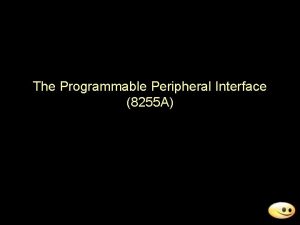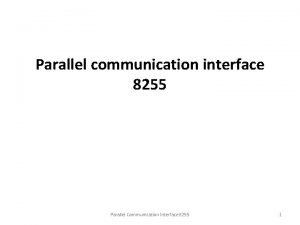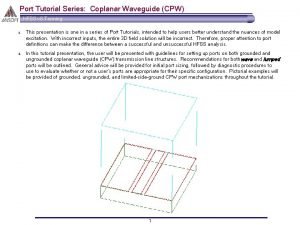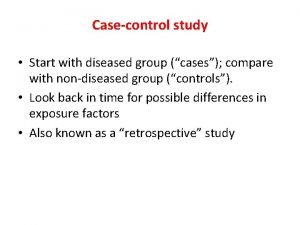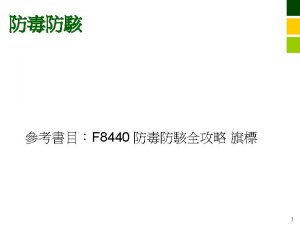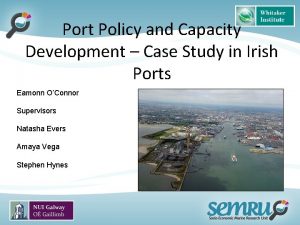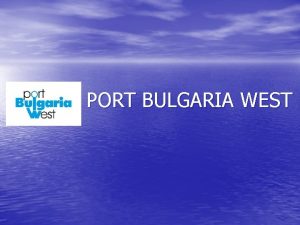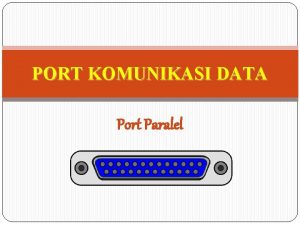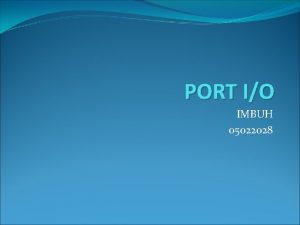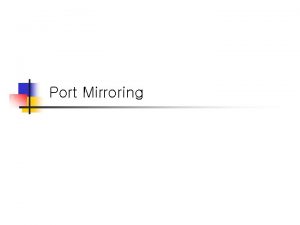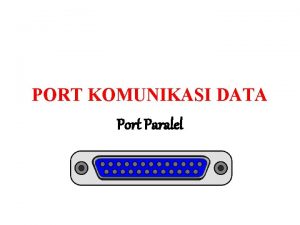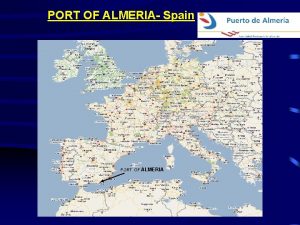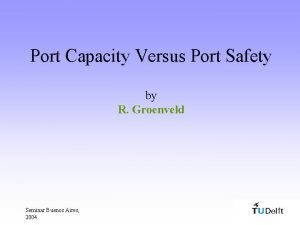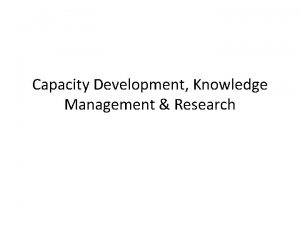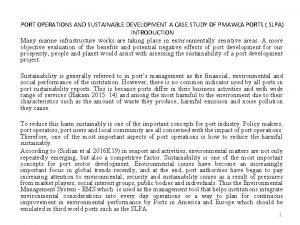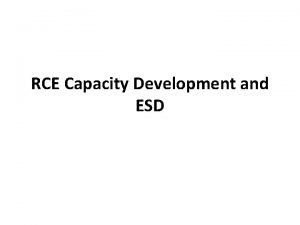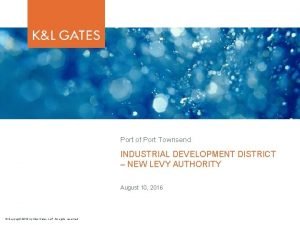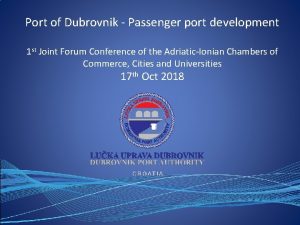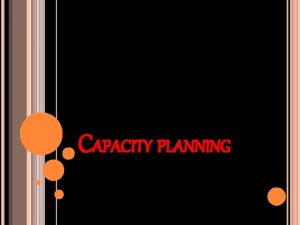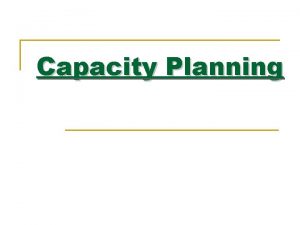Port Policy and Capacity Development Case Study in



























- Slides: 27

Port Policy and Capacity Development – Case Study in Irish Ports Eamonn O’Connor Supervisors Natasha Evers Amaya Vega Stephen Hynes

Outline 1. Motivation 2. Methodology 3. Preliminary Findings 4. Discussion

1. Motivation

Motivation Given the prominence of seaborne trade the provision of port capacity is widely recognised as critical for the capability of regions to trade internationally. In many jurisdictions responsibility for developing capacity is often spread across multiple independent port authorities Policy makers must ensure that there is appropriate adaptive capacity within the network of port systems to meet future capacity requirements. The challenge for policy makers is designing appropriate policy frameworks given the role contextuality across a range of port systems. The objective of research is therefore to explore the role of national policy on capacity development across a range of ports given contextuality

2. Methodology

Methodology Case study of Irish state owned ports using embedded single case design Levels of Analysis Meso – Range of Ports that comprise the Irish port system Focus of Enquiry - Identifying the factors that are influencing the development of cargo traffic flows Micro – Individual Port systems and port authorities mandated with developing port capacity to meet national requirements Focus of enquiry – Identifying the factors that are influencing how port managers are developing capacity in their respective port systems

Methodology Meso – Examination of Port Traffic Flows in the context of key influencing factors using Notteboom and Roderiques (2007) conceptualisation of the port hinterland into three groups of factors - macroeconomic, physical and logistical over the period 2000 -2016 Micro – Semi-structured interviews with senior executives of port companies tasked with responsibility for the development of port capacity were chosen as the primary data collection technique, supplemented with available secondary sources (corporate documents and reports). Analysis following approach of Miles and Huberman (1994) - data analysis reduced to three cyclical phases: Data reduction, visual display and drawing and verifying conclusions.

3. Findings

Cargo Traffic Flows Unitised

Unitised Sector in Ireland Source: Intertrade ireland 2005

Market Concentration 70% 60% Gini Dublin 50% Belfast Larne 40% Rosslare Waterford 30% Cork 20% Warrenpoint Drogheda 10% Dun Laoighre 0% 1 2 3 Own elaboration based on CSO Data 4 5 6 7 8 9 10 11 12 13 14 15 16 17

Growth Across Ports RORO Total 2000 (000's) 2016 (000's) CAGR LOLO 18, 925 26, 427 2. 1% Total LOLO Dublin 6, 536 12, 667 4. 2% Dublin Belfast 4, 551 6, 615 2. 4% Cork Larne 4, 507 2, 746 -3. 0% Warrenpoint 1, 002 2, 182 5. 0% Rosslaere 1, 913 2, 133 0. 7% Cork Dun Laoighre Belfast Waterford Warrenpoint 191 225 Source: Own Elaboration based on CSO data 84 - 2000 (000's) 7, 71 5 4, 17 6 96 8 1, 29 4 1, 01 4 15 9 2016 (000's) CAGR 9, 1 56 1% 5, 0 62 1% 1, 8 89 4% 1, 6 80 2% 2 79 -8% 2 46 3% -5. 0% -100. 0% Drogheda 4 10 - -100%

Patterns of Trade Exports Imports Trade Value (Euro) 140000000 120000000 10000 80000000 60000000 40000000 20000000 0 2001 2002 2003 2004 25, 000 2005 2006 2007 2008 2009 2010 2011 2012 2013 2014 2015 2016 Trade Volume (Tonnes) 20, 000 15, 000 10, 000 5, 000 0 2001 Own Elaboration Based on CSO Data 2002 2003 2004 2005 2006 2007 2008 2009 2010 2011 2012 2013 2014 2015 2016

Commodities Traded Own Elaboration Based on CSO Data

Destinations of Trade GB Own Elaboration Based on CSO Data EU Non-EU

Trade imbalance between Imports and Exports Ro. Ro Imports Ro. Ro Exports Lolo Imports Lolo Exports 25000 8000 7000 20000 6000 5000 15000 RORO 4000 LOLO 10000 3000 2000 5000 1000 0 0 2001 2002 2003 2004 2005 2006 2007 2008 2009 2010 2011 2012 2013 2014 2015 2016 Own Elaboration Based on CSO Data

Physical Developments since 2000 Major upgrading of Road Network Concentration of surface transport infrastructure around Dublin City. Improved Accessibility to ports particularly Dublin Minor Upgrading of Port infrastructure across the country, most notably Belfast and Waterford Source: Competition authority 2013

Logistics Trends Shipping Lines Logistic Service Providers Consolidation in through mergers and The increased centralisation of acquisitions and concentration in routes inventory amongst logistics service in both Lo. Lo and Ro. Ro providers in the Greater Dublin Area (GDA) (Intertrade Ireland 2005) Introduction of highly successful direct continental CONRO service from Dublin from 2009 The increased utilisation of hub and spoke networks with hubs in the GDA, Rise of Vessel sharing Arrangements in UK (utilising Ire-UK landbridge) and Lo. Lo sector in early 2000’s with nearly mainland Europe (Belgium and Holland) all operators employing VSA’s by 2010 (IMDO) Continued prevalence of Road transport Note: Consolidation in both markets (99% Road CSO) accelerated by effects of the recessionary period

Factors Influencing Observed Trend of centralisation around core ports - Value/volume differential between imports and exports favours concentration of logistics networks around large importation bases i. e. centres of population - Inability to balance loads put ports in exporting corners at disadvantage despite efficiency of port services - Added Reliability of Ro. Ro over Lo. Lo further gives Dublin an advantage for increasingly time sensitive high value cargos - Major driver of port traffic flows are efficiencies afforded to logistics service providers Population Density Map of Ireland

National Port Policy (2013) 5 Ports maintained as state owned commercialised port companies as follows: Tier 1 – Dublin Port, Port of Cork and Shannon Foynes Port Company Tier 2 – Rosslare Europort and the Port of Waterford Tier 1 ports mandated to “lead the response of the state commercial ports sector to future national port capacity requirements” Tier 2 ports have a role to “develop additional capacity to aid competitive conditions within the unitised sectors in particular” Ports to receive no exchequer funding for infrastructure development or otherwise

Factors Affecting Capability of Port Managers to Respond through addition of capacity 1. Location of the port and capability to generate traffic flows o o Size and import/export balance in hinterland Power of Intermediaries 2. Slack in Availability of Physical Resources o Suitable land depth of water 3. Access to main inland transportation networks o Reliance on external bodies to develop connecting infrastructure 4. Port operating model and level of private sector participation

Factors Affecting Capability of Port Managers to Respond 5. Capability to Leverage Finance 6. Capability to leverage Social License to Operate o Difficulty in obtaining planning permissions and regulatory licenses o External Pressures from non-commercial stakeholders to realise value for port lands o Environmental and Social issues associated with port operations o Support from local and national authorities

4. Discussion

Discussion Context distorts the effect of common policy framework, Ø Inherent capability to leverage key resources for port development differs in different port contexts 1. Scale of operations has consequences for capability to leverage finance contingent on the traffic sector 2. Geographic location and legacy of dealings with local authorities creates differences in capability to obtain social license to operate across port systems • Critical in the Irish context is supply/competition for critical physical resources

Potential Challenges ahead Longer Term: Capacity Constraint in Dublin due to scarcity of land may ultimately bound the current centralisation of port traffic flows around Dublin Port and force a deconcentration of port traffic flows to other ports. Shorter Term: The impact of a hard border between Ireland the UK will have consequences for the relative attractiveness of the UK land bridge and the imposition of a hard border will put strain on the capability of Dublin port to respond due to land constraints Key Policy Question: is there enough adaptive capacity in the meso level to facilitate a movement toward deconcentration? What is the role of policy makers in facilitating this shift?

Discussion Points Role for Policy Makers in reducing uncertainty surrounding port development process at micro level – Improvements in integrated planning approach reducing uncertainty around obtaining planning permissions and regulatory approvals - Policy to ensure there are funding mechanisms available to port managers across system that do not put an overly burdensome constraint on future development

Thank You!
 8255 a is a
8255 a is a Parallel communication interface
Parallel communication interface Hfss coplanar waveguide
Hfss coplanar waveguide Channel capacity planning
Channel capacity planning Best case worst case average case
Best case worst case average case Project failure case study
Project failure case study Sam, and verna coursework answers
Sam, and verna coursework answers Short case vs long case
Short case vs long case Average case complexity of binary search
Average case complexity of binary search Bubble sort algorithm pseudocode
Bubble sort algorithm pseudocode Bubble sort best case and worst case
Bubble sort best case and worst case Bubble sort best case and worst case
Bubble sort best case and worst case What is a unique triangle
What is a unique triangle Machinery valuation report
Machinery valuation report Phenomenology vs ethnography
Phenomenology vs ethnography Case study on deforestation in andaman and nicobar islands
Case study on deforestation in andaman and nicobar islands Risk management case study oil and gas industry
Risk management case study oil and gas industry Amazon and whole foods merger case study
Amazon and whole foods merger case study Case study on enterprise architecture and integration
Case study on enterprise architecture and integration Raleigh and rosse case study
Raleigh and rosse case study Kelemahan penelitian studi kasus
Kelemahan penelitian studi kasus Case study ethan and college expenses
Case study ethan and college expenses Social and ethical issues in information systems
Social and ethical issues in information systems Longitudinal prospective study
Longitudinal prospective study Case control study example
Case control study example Toxteth and lympstone
Toxteth and lympstone Tesco fresh and easy case study
Tesco fresh and easy case study Nationalism case study italy and germany
Nationalism case study italy and germany
